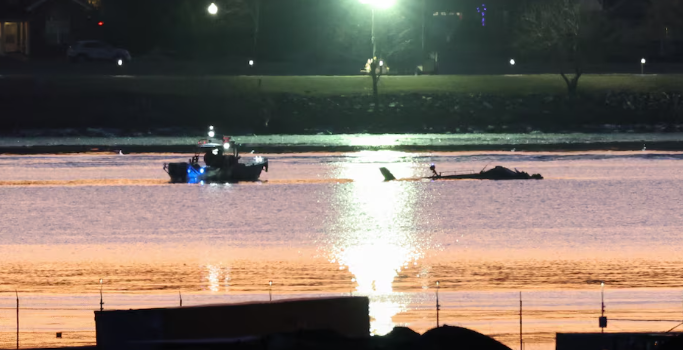Tragic Mid-Air Collision Over Washington D.C.: More Than 60 Feared Dead
WASHINGTON, Jan 29 (Reuters) – A devastating mid-air collision between an American Airlines regional jet and a U.S. Army Black Hawk helicopter sent both aircraft plummeting into the icy Potomac River near Reagan Washington National Airport on Wednesday night. Authorities fear there are no survivors.
“At this point, we do not believe there were any survivors,” said District of Columbia Fire Chief John Donnelly during a press conference Thursday. Recovery efforts have been grueling, with emergency teams pulling 28 bodies from the water so far. Officials warn this could become the deadliest U.S. air disaster in more than two decades.
Passenger Jet Carrying 64, Including Figure Skating Champions
The ill-fated American Eagle Flight 5342, operated by PSA Airlines, carried 60 passengers and four crew members. Tragically, among those on board were renowned Russian-born figure skaters Yevgenia Shishkova and Vadim Naumov, along with several young athletes, their families, and coaches returning from an event in Wichita, Kansas.
“We have been told that there are no survivors. We mourn with all those who have been impacted,” said a visibly emotional Wichita Mayor Lily Wu.
Meanwhile, the Black Hawk helicopter carried three U.S. Army soldiers on a routine training flight. The Army unit involved has since paused all helicopter operations pending an investigation.
Collision Moments Before Landing
According to preliminary reports, the mid-air disaster unfolded as the passenger jet was descending for its final approach at Reagan National Airport. Radio transcripts reveal the Black Hawk crew was aware of the plane’s presence, yet the collision still occurred.
A recovered air traffic control recording captures the tense final seconds:
“PAT25, do you have a CRJ in sight? PAT25, pass behind the CRJ,” a controller warns.
Seconds later, another aircraft on the frequency urgently asks:
“Tower, did you see that?”
A webcam recording captured the horrific moment—an explosion lit up the night sky, and both aircraft vanished into the freezing waters below.
“Do I Think This Was Preventable? Absolutely.”
Speaking to reporters, U.S. Transportation Secretary Sean Duffy confirmed that both aircraft had been following standard flight paths, and no immediate communication failures had been identified.
“Everything was standard in the lead-up to the crash,” he said. “Do I think this was preventable? Absolutely.”
Concerns over crowded airspace in the Washington D.C. region have been rising for years, given its three major commercial airports and multiple military installations. A similar near-miss incident was reported just last May.
Investigation Underway, Flights Set to Resume
Rescue divers have recovered one of the two flight recorders from the wreckage, which investigators hope will provide answers.
John Potter, head of the regional airport authority, announced that flights at Reagan National will resume at 11 a.m. Eastern (1600 GMT), as authorities continue their efforts to recover victims and piece together what went wrong.
A highly trained helicopter crew, equipped with night-vision goggles, was conducting an annual proficiency training flight when tragedy struck, Defense Secretary Pete Hegseth confirmed in a video statement.
In the wake of the disaster, former President Donald Trump announced he would hold a press briefing at 11 a.m. Eastern (1600 GMT). Earlier, he took to Truth Social to voice his frustration, questioning the actions of both the helicopter crew and air traffic controllers.
“This is a bad situation that looks like it should have been prevented. NOT GOOD!!!” he wrote.
The ill-fated American Eagle Flight 5342, operated by PSA Airlines, was a CRJ-700 regional jet—originally built by Canada’s Bombardier and later sold to Mitsubishi. American Airlines CEO Robert Isom revealed that the pilot had six years of experience, emphasizing that the airline was fully cooperating with the NTSB investigation.
Chilling air traffic control recordings provide insight into the crash’s final moments. As the Black Hawk helicopter, call sign PAT25, maneuvered near the airport, a controller urgently radioed:
“PAT25, do you have a CRJ in sight? PAT25, pass behind the CRJ.”
Moments later, the unthinkable happened. Another pilot on the frequency reacted in real time:
“Tower, did you see that?”
Webcam footage captured the fiery collision, with an explosion illuminating the night sky before the aircraft plunged into the frigid Potomac River. An air traffic controller, still in shock, was overheard saying:
“I just saw a fireball, and then it was just gone. I haven’t seen anything since they hit the river.”
Despite the chaos, officials are working swiftly to restore operations. John Potter, head of the regional airport authority, announced that flights at Reagan National Airport are scheduled to resume at 11 a.m. Eastern (1600 GMT).
RESCUE EFFORTS
Skating World Devastated by Tragic Loss
The tight-knit figure skating community is mourning an unimaginable tragedy after several of its own perished in the devastating mid-air collision over Washington, D.C. The skaters, along with their families and coaches, were returning from a training camp in Wichita, U.S. Figure Skating confirmed.
“Skating isn’t just a sport—it’s a family,” said a visibly shaken Doug Zeghibe of the Skating Club of Boston, where legendary coaches Yevgenia Shishkova and Vadim Naumov mentored young athletes. Among the victims were two teenage skaters from the club and their mothers.
“We have lost family,” Zeghibe said through tears.
Reports from Russia’s Mash news outlet indicate that 13 of the passengers were skaters, many of them children of Russian emigrants who had built their futures in the United States. The Kremlin extended its condolences but stated there were no plans for discussions between President Vladimir Putin and President Trump at this time.
Difficult Rescue Efforts Amid Harsh Conditions
As recovery operations continue, Washington D.C. Fire Chief John Donnelly described the conditions as extremely rough, with freezing waters, powerful currents, and gusty winds making the mission even more challenging for the 300 responders on the scene.
Meanwhile, Virginia Governor Glenn Youngkin confirmed that most of the victims’ bodies have been recovered but admitted, “Everything seemed routine up until the accident. Something went wrong.”
The world of figure skating—and the families of those lost—are left grieving as authorities work to piece together what led to this catastrophic collision.

Aviation Tragedy: The Deadliest U.S. Air Disaster in Over Two Decades
This catastrophic collision is poised to become the deadliest U.S. air disaster since November 2001, when an American Airlines jet crashed shortly after takeoff from John F. Kennedy International Airport, claiming the lives of all 260 people on board and five on the ground.
The tragedy also underscores growing concerns about aviation safety in the U.S. Over the past two years, a surge in near-miss incidents has raised alarms about the strain on understaffed air traffic control operations and the intense congestion in American airspace.
At the heart of these concerns is Reagan National Airport, where the main runway—one of the busiest in the country—handles more than 800 takeoffs and landings daily. Records show that the National Transportation Safety Board (NTSB) has investigated nine accidents or incidents at Reagan National since 2000, two of which were fatal.
A History of Tragedy in Washington’s Skies
The crash occurred just miles from sites that have seen some of the most harrowing air disasters in U.S. history. Reagan National sits only two miles from the White House and half a mile from the Pentagon, where 189 people perished on September 11, 2001, when Al Qaeda hijackers crashed American Airlines Flight 77 into the building.
The Potomac River, now the site of this latest tragedy, was also the scene of another devastating crash. In 1982, Air Florida Flight 90 slammed into the 14th Street Bridge before plunging into the icy river, killing 70 passengers and four crew members. Miraculously, only five people survived.
Now, as investigators sift through the wreckage and families mourn, the nation once again faces urgent questions about aviation safety—and whether this disaster could have been prevented.



